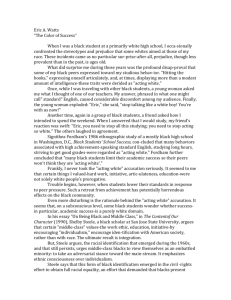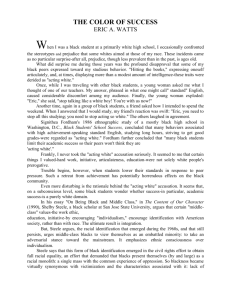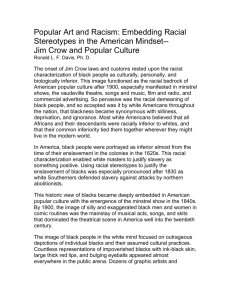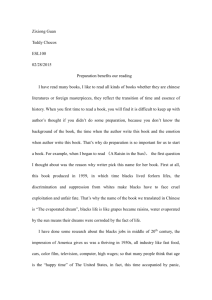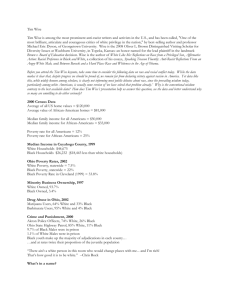THE HEALTH OF BIACK FOLK
advertisement
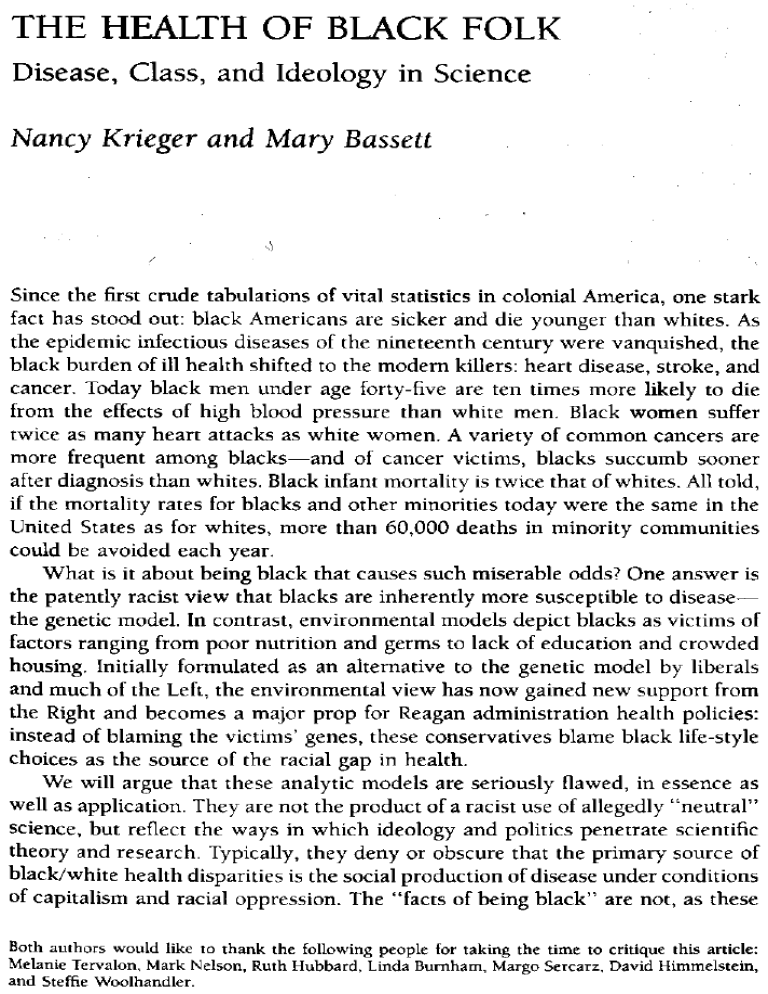
THE HEALTH OF BIACK FOLK
Disease, Class, and Ideology
in
Science
Nancy Krieger and. Mary Bassett
Since the first crude tabulations of vital statistics in colonial America, one stark
fact has stood out: black Americans are sicker and die younger than whites. As
the epidemic infectious diseases of rhe nineteenth century were vanquished, the
black burden of ill health shifted to the modem killers: heart disease, stroke, and
cancer. Today black men under age forty-five are ren times more likely to die
from the effects of high blood pressure than white men. Black women suffer
twice as many heart attacks as white women. A variety of common cancers are
more frequent among blacks-and o[ cancer victims, blacks succumb sooner
after diagnosis than whites. Black infanr mortaliry is twice that ofwhites. AII told,
if the mortality rates for blacks and other minorities today were the same in rhe
United States as for whites, more than 60,000 deaths in minority communities
could be avoided each year.
What is it about being black that causes such miserable odds? One answer is
the patently racist view that blacks are inherently more susceptible to diseasethe genetic model. In contrast, environmental models depict blacks as victims of
factors ranging from poor nutrition and germs to lack of education and crowded
housing. Initially formulated as an alternative to the genetic model by liberals
and much of the Left, the environmental view has now gained new support from
the Right and becomes a major prop for Reagan administration health policies:
instead of blaming the vicrims' genes, th€se conservatives blame black life-style
choices as the source of the racial gap in health.
We will argue that these analytic models are seriously flawed, in essence as
well as application. They are not the product of a racist use of allegedly "neutral"
science, but reflect the ways in which ideology and polirics penetrate scientific
theory and research. Typically, they deny or obscure that the primary source of
black/white health disparities is the social production ofdisease under conditions
of capitalism and racial oppression. The "facts of being black" are not, as these
Both authors would like to thank the folowing people for taking the rime to cririque this articl€:
Metanie T€rvalon, Mark Nelson, Rurh Hubbard. Linda Bumham, Marqo Sercarz, David Himmelstein,
and Steme Woolhandler.
162 /
Scietce Constructs "Rdce"
models suggest, a genetically determined shade of skin color, or individual deprived living conditions, or ill-informed life-style choices. The facts of being
black derive from the joint social relations of race and class: racism disproportionately concentrates blacks into the lower strata of the working class and further causes blacks in all class strata to be racially oppressed lt is the Left's
challenge to incorporate this political reality into how we approach racial differences
in health.
The Genetic Model
Despite overwhelming evidence to the contrary, the theory that "race" is primarily a biological category and that black-white differences in health are Senetically
determined continues to exert profound influence on both medical thinking and
popular ideology. For example, an editorial on racial differences in birth weight
(an important determinant of infant mortality) in the January 1986 loutnal oJ the
American Medicdl Association concluded: "Finally, what are the biologic or genetic differences among racial or ethnic groups? Should we shrink from the possibility of a biologic/genetic influence?" Similarly, a 1983 handbook prepared by
the tntemational Epidemiologic Association defined "race" as "persons who are
relatively homogeneous with respect to biological inheritance." Public health
texts continue to enshrine "race" in the demographic triad of "age, race, and
sex," implying that "race" is as biologically fundamental a predictor of health as
aging or sex, while the medical literature remains replete with studies that examine racial differences in health without regard to class.
The genetic model rests on three basic assumptions, all of which are flawed:
that "race" is a valid biological category; that th€ Senes which determine "race"
are linked to the genes which affect health; and that the health of any community
is mainly the consequence of the genetic constitution of the individuals of which
it is composed. In contrast, we rir'ill argue that the health of the black community
is not simply the sum of the health of individuals who are "Senedcally black" but
instead chiefly reflects the social forces which create racially oppressed commu-
nities in the first place.
It is o[ course true that skin color. hair texture. and other visible features used
to identify "race" are genetically encoded-there is a biologic aspect to "race."
The importance of these particular physical traits in the spectrum of human variation, however, has been determined historically and politically. People also differ in terms of stature and eye color, but these attributes are rarely accorded
significance. Categories based primarily on skin color correlate with health because race is a powerful determinant of the location and life-destinies of individuals within the class structure of U.S. society. Ever since plantation owners
realized that differences in skin color could serve as a readily identifiable and
permanent marker for socially determined divisions of labor (black runaway
slaves were easier to identify than escaped white indentured servants and con-
THE HEALTH OF BLACK
FOLK /
163
victs, the initial workforce of colonial America), race and class have been rnextrr_
cably intertwined. "Race" is nor a neurral descriptive category, but a social
category both of the antagonistic relation of white supremacy and black oppres_
sion. The basis of the relative health advantage of whites is not to be found in
their genes but in the relative material advantage whites enjoy as a consequence
of political prerogative and state power. As Richard Lewontin has pointed out,
"lf, after a grear cataclysm, only Africans were left alive, the human species
would have retained 93 percent of irs total genetic variarion, although the species
as a whole would be darker skinned." The fact thar we all know which race we
belong to says more about our society than about our biology.
Nevertheless, the paradigm of a genetic basis for black ill health remains
strong. In its defense, researchers repeatedly trot out the few diseases for which a
clear-cut link of race is established: sickle cell anemia, G6zpD deficiency, and
lactose intolerance. These diseases, however, have a tiny impact on the health of
the black population as a whole-if anything, even less than those few diseases
linked to "whiteness," such as some forms of skin cancer. Richard Cooner has
shown that of the tens of thousands of excess black deaths in 1977, onty iZZ 1O.l
percent) could be attribured to diseases such as sickle cell anemia. Such uncommon genetic maladies have become importanr srricdy because of their metaphorical value: they are used to support gen€ric explanarions of racial differences in
the "big diseases" of the twentieth century-heart disease, stroke, and cancer.
Yet no current evidence exists ro justify such an extrapolarion.
Determined nonetheless to demonstrate the qenetic basis of racial health differences, investigators today-like rheir peers in rhe pasr-use the latest techniques. Where once physicians compared cranial capacity to explain black-white
inequalities, now they scrutinize surface markers of cells. The case of hypertension is particularly illustrative. High blood pressure is an important cause of
strokes and heart attacks, contributing to about 30 percent of all deaths in the
United States. At present, the black rare of hypertension in the Unit€d States is
about twice that of whites. Of over five hundred recent medical journal articles
on the topic, fewer than a dozen studies explored social factors. The rest instead
unsuccessfully sought biochemical-generic explanations-and of these, virtually
none even attempted to "define" genetically who was "white" and who was
"black," despite the alleged genetic nature of their enquiry. As a consequence of
rne wrong quesrions being asked, the causes of hypertension remain unknown.
Nonetheless, numerous clues point to social factors. Hypertension does nor exisr
in several undisrupted hunter-gatherer tribes of different "races" but rapidly
emerges in these tribes after contact with industrial society; in the United States,
Iower social class begets higher blood pressure.
. Tuming to cancer, the authors of a recent major govemment report surmised
that blacks have poorer survival rates than whites because they do not "exhibit
tne same immunologic reactions to cancerous processes." tt is noteworthy, however, that the comparably poor survival rates of British breast cancer patients
nave never elicited such speculation. In our own work on breast cancer in Washrngton state, we found that the striking "racial" difference in survival evaporated
161 /
Science Constrxcts "Race"
when we took class into account: working-class women, whether black or white,
die sooner than women of higher social class standing.
To account for the persistence of the genetic model' we must look to its politi-
cal significance rather than its scientific content. First used to buttress biblical
arguments for slavery in a period when science was beginning to replace religion
as sanction for the status quo, the genetic model of racial differences in health
emerged toward the end of the eighteenth century, long before any precise theory of heredity existed. ln well-respected medical joumals, doctors debated
whether blacks and whites were even the same species (let alone race), and
proclaimed that blacks were intrinsically suited to slavery, thrived in hot climates, succumbed less to the epidemic fevers which ravaged the South, and
suffered extraordinary rates of insanity if allowed to live free After the Civil war
effectively settled the argument about whether blacks belonged to the human
species, physicians and scientists began elaborating hereditarian theories to explain the disparate health profiles not only of blacks and whites, but of the different white "races"-as defined by national origin and immigrant status. Virtually
every scourge, from TB to rickets, was postulated to be inherited. Rheumatic
fever, now known to be due to strep bacteria combined with the poverty which
permits its expression in immunocompromised malnourished people, was long
believed to be linked with the red hair and pale complexions of its lrish workingclass victims. Overall, genetic explanations of differences in disease rates have
politically sewed to justify existing class relations and excuse socially created
afflictions as a result of immutable biology.
Nowadays the genetic model-newly dressed in the language of molecular
genetics-continues to divert attention from the class origin of disease Genetic
explanations absolve the state of responsibility for the health profile of black
America by declaring racial disparities (regrettably) inevitable and normal. lntervention efforts based on this model founder for obvious reasons: short of recornbinant DNA therapies, Senetic screening and selective reproduction stand as
supposed tools to reduce the racial gap in health
Unfortunately, the genetic model wields influence even within the progressive health movement, as illustrated by the surge of interest in sickle cell anemia
in the early I970s. For decades after its initial description in 1925, sickle cell
anemia was relegated to clinical obscurity. lt occurs as often in blacks as does
cystic fibrosis in vr'hites. By linking genetic uniqueness to racial pride, such
groups as the Black Panther party championed sickle cell anemia as the number
one health issue among blacks, despite the fact that other health problems-such
as infant mortality-took a much greater toll. Because the sickle cell Sene provides some protection against malaria, sickle cell seemed to link blacks to their
African past, now three centuries removed. lt raised the issue of racist neglect of
black health in a setting where the victims were truly blameless: the fault lay in
their genes. From the point of view of the federal govemment, sickle cell anemia
was a uniquely black disease which did not raise the troubling issues of the
ongoing oppression of the black population. ln a period of political turmoil, what
THE HEALTH OF BLACK
FOLK /
165
more could the government ask for? Small wonder that president Nixon jumped
on the bandwagon and called for a national crusade.
The Environmental Model
The genetic model's long history and foundations in the ioint race and class
divisions of our society assure its conrinued prominence in discussions on the
racial gap in health. To rebut this model, many liberals and progressives have
relied upon environmental models of disease causation-only to encounter the
Right on this turf as well.
Whereas the rise of slavery called forth genetic models of diseases, environmental models were bom of the antagonistic social relations o[ industrial capital_
ism. In the appalling filth of nineteenth-century cities, tuberculosis, typhus, and
infant diarrhea were endemic in the newly forming working class; periodically,
epidemics of yellow fever and cholera would attack the entiie popuiace. A sanitary reform movement arose, advocating cleaner cities (with sewir systems and
pure water) to protect the well-being of the wealthy as well as the poor, and also
to engender a healthier, more productive work lorce.
In the United States, most of the reformers were highly moralistic and
staunchly procapitalist, seeing poverty and squalor as consequences of individual
intemperance and ignorance rather than as necessary correlates of capital accu_
mulation. ln Europe, where the working-class movement was stronger, a class_
conscious wing of the sanitary reform movement emerged. Radicals such as Fred_
erick Engels and Rudolph Virchow (arer the foundeiot modern pathology) ar-
gued that poverty and ill health could only be eliminated by resolving the
antagonistic class relations of capitalism.
The early sanitary reform movement in the United Srates rarely addressed the
question of racial differences in health per se. ln fact, environmental models
to
explain black-white disparities emerged only during the mid-twentieth cenrury,
a consequence of the urban migration of blacks from
the rural South to the indus_
trial North and the rise of the civil-rights movement.
.._ Today's liberal version of the environmental model blames poverry for black
ill health. The noxious features of the "poverty environment,,
are catalogued and
decried-lead paint {rom tenement walls, toxins from work, even
social features
rrke discriminarion. But as in most liberal analyses,
the unifying cause of this
Iitany of woes remains unstated. We are left with
an appa.entiy unconnected
laundry lisr of problems and no explanation of why
blacks as a group encounter
srmilar sickenins conditions.
The liberal view fetishizes the environment: individuals
are harmed by inanimate objects, physical forces, or unfortunate
social conditions Qike poverty)_by
things rather than by people. That these
objects or social circumstances are the
c/eotions of society is hidden by the veil of ,,natural
science." Consequently, the
166 /
Science Constructs "Race"
"environment" is viewed as a natural and neutral cat€gory, defined as all that is
external to individuals. what is not seen is the ways in which the underlying
structure of racial oppression and class exploitation-which are relationships
people, not between people and things-shape the "environments" of the
among
groups created by these relations.
The debilitatittg disease pellagra serves as a concrete example Once a major
health problem of poor southern farm and mill laborers in the United States'
pellagra was believid to be a genetic disease. By the early I920s, however' Joseph"Goldberger had proved that the disease stemmed from a dietary deficiency
in niacin and had also demonstrated that pellagra's familial nature existed because of the inheritance of nutritional options, not genes Beyond this' Goldberger argued that pellagra, in essence, was a social disease caused by the single
of the South: reliance on cotton ensured seasonal starvation
a^rt-a.of
"aono-y
the cotton
as food ran out between harvests, as well as periodic epidemics when
had limthey
because
pellagra
contracted
market collapsed. Southem workers
workers
Yet
southem
were
they
because
ited diets-and they had limited diets
to
according
with
niacin:
food
to
supplement
governmental response was simply
the
malnutrition-was
determined
socially
ihis vie*. vitamin deficiency-not
chief cause of pellagra.
The liberal version of the environmental rnodel also fails to see the causes of
disease and the environment in which they exist as a historical product' a nature
filtered through, even constructed by, society. What organisms and chemicals
people are e*lposed to is determined by both the social relations and types of
production which characterize their society. The same virus may cause pneumonia in blacks and whites alike, just as lead may cause the same physiologic damage-but rthy the death rate for flu and pneumonia and why blood lead levels are
cJnsistently iigher in black as compared to white communities is not addressed'
While the iiberal conception of the environment can generate an exhaustive list
of its components, it cannot comprehend the all-important assemblage of features
of black liie. What explains why a greater proportion ofblack mothers are single,
malnourished, high-school dropouts, and so on?
young,
'
Here the Right is ready with a "life-style" response as a unifying theme:
blacks, not racism, are the source of their own health woes Currently, the Reagan administration is the chief promoter of this view-as made evident by the
1985 publication of the Report of the Secretary's Task Force on Black and Minority Health. Just one weapon among many in the government's vicious ideological
war to justify its savage gutting of health and social service programs, the report
shifts responsibility for the burden ofdisease to the mino ty communities themselves. Piomoting "health education" as a Panacea, the government hoPes to
corrnsel minorities to eat better, exercise more' smoke and drink less, be less
violent, seek health care earlier for symptoms, and in general be better healthcare consumers. This "life-style" version of the environmental model accordingly is fully compatible with the genetic model (i.e., genetic disadvantage can be
by llfe-style choices) and echoes its ideological messages that indi"*"gg"r"a"d
vidual shortcominqs are at the root of ill health
THE HEALTH OF BIACK
FOLK /
167
ln focusing on individual health habits, the task force report ironically echoes
the language of many "health radicals," ranging from iconoclasts such as lvan
lllich to counterculture advocates of individually oriented self-help strategies.
United in practice, if not in spirir, these apparently disparate camps all take a
"holistic" view, arguing that disease comes notjust from germs or chemicals but
from life-style choices about food, exercise, smoking, and stress. Their conflation
of life-style choices and life circumstance can reach absurd proportions. Editorializing on the task force report, the New Yorh Times agreed that "Dispariries may
be due to cultural or lifestyle differences. For example, a higher proportion of
blacks and hispanics live in cities, with greater exposure to hazards like pollurion, poor housing, and crime." But what kind of "life-style" causes pollution,
and who chooses to live in high-crime neighborhoods? Both the conservative and
altemative "life-style" versions of the environmental model deliberately ignore
or distort the fact that economic coercion and political disenfranchisemenr, not
free choice, locate minodty communities in the most hazardous reqions of cities.
What qualitatively consrrains the oprion o{ btacks ro "live right" ii the reality of
being black and poor in the United Srares.
But liberals have had little response when the Right points out that even the
most oppressed and impoverished people make choices affecting their health: it
may be hard to eat right if the neighborhood grocer doesn't sell fresh vegetables,
but teenage girls do not have to become pregnant. For liberals, it has been easier
to portray blacks as passive, blameless victims and in this way avoid the highly
charged issue of health behaviors altogether. The end result is usually just proposals for more health services.;tor blacks, Band-Aids for the gaping wounds of
oppression. Yet while adequate health sewices certainly are needed, they can do
little to stem the social forces which cause disease.
Too often the Left has been contenr merely to trail behind the liberals in
campaigns for health services, or to call only for social control of environmental
and occupational exposures. The Right, however, has shifted the terrain o[battle
to the issue of individual behavior, and we must respond. It is for the Left to point
out that society does not consist of abstract individuals, but rather of people
whose life options are shaped by their intrinsic membership in groups defined by
the social relations of their society. Race and class broadly determine not only
the conditions under which blacks and whites live. but also the wavs in which
they can respond to these conditions and the polirical power they have to alter
them. The material limits produced by oppression create and constrain not only
the type of housing you live in, but even rhe most inrimate choices about what
you do inside your home. Oppression and exploirarion beget the reality and also
the b€liel that bad health and personal failure are ineluctable facts of life.
frantz Fanon wrote eloquently of the fatalistic hopelessness engendered by
oppression in colonial Algeria. Eliminaring self-destructive behaviors, like drug
aodiction or living In a barrering relarionship, requires rhat they be acknowldged as the subjective reflection of objective powerlessness. As Bylle Avery,
qtrector of the National Black Women's Health project,
has said, wellness and
empowerment are linked. School-based birth control clinics, however necessary
168 /
Science Constructs "Race"
part of the strategy to reduce teen pregnancy, will be ineffective as long as the
unaddressed;
ao.iui -o,**io" f# young black women to get Pregnant remains
to act
choose
individually
for black women to improve their health, they must
constrain'
frame'
which
in order toiransform the social conditions
ct
".tiu"ty
and devalue their lives as black women
as
Toward a Marxist ConcePtion
rejected
The ideological content of science is transParent in disease models now
"o,
of
retribution
as
disease
indisputably biased. The feudal view of
u, ur.t ui.
resonated
clearly
God and the eugenist science underlying Nazi racial hygiene
But it is
well with the doirinant politics and ideology of their respective societies
in
one's
theory
far rnore difficult to disiem the ideological content of scientific
own time and place.
tool
Criticism oi the ideology underlying existing paradigms is an important
riddle
of
apParent
the
in undermining reactionary science lt can help us sort out
ih" n"ngutt ud"-irrirtr"tion', embrace of "holistic" health Such criticism also
howpoints tie *ay toward alternative concepts To construct a new paradigm'
"neutral" science'
ever, requires painstaking work. Moreover, the goal is not a
is
bu, or," *ti.h openly a&nowledges the ways in which ideology inevitably
preand
elucidation
Accurate
inco.po.rt"d into scientific concepis attd theories
venti;n of the material and ideological components of disease processes necessitates the explicit adoption o[ an antiracist and class-conscious standpoint
of race
We have only a hint of how a Marxist analysis of the social relations
of disproduction
social
and class can illuminate the processes involved in the
in
"racial"
differences
ease. Such an approach has already shown that many
of
finding
the
Similarly'
act.taliy attributable to differences in class
air""r"
"t"
someMarxist.er""tch"rrthatanabsenteelandlord,ratherthanrace'isthebest
predictor of lead poisoning points to what this new science can offer in the way
oI prevention.
But these are small, isolated observations Too often we are constrained by
assumptions built into existing techniques and methodologies The intimidating
mathe;atics of multiple regression which dominate public health reseatch canway
not even contemplate an effect which becomes its own cause-such as the
which
diarrhea'
in *hich malnr.ttrition opens the way for infections, which cause
phecauses malnutrition. Further, existing analytic techniques cannot address
as
expressed
be
nomena like class relations or racial oppression which cannot
or
income
less
or
numbers. True, we can calculate the health effect of more
not
and
outcomes
education, but these are pale reflections o[ class relations,
li-it.d by disease deFnitions geared toward individessences. Similarly, *"
"."
infant
ual etiology. Treating the proble-s oi substa"te abuse, in[ectious disease'
malaas
separate
community
in the black
mortalityland occuf"tiorr"l
"*por,tr"
new
basically
we
need
Clearly,
dies obscures their common social antecedent
THE HEALTH OF BLACK
FOLK /
169
approaches to understand the dialectical interp€netration of racism, class relations, and health.
To unravel and eliminate black-white differences in disease, we must besin
by politically exposing, not merely describing, rhe social roots of suffering ;d
disease. Throughout U.S. history, the functioning of capitalism has been bound
up with the exploitarion and racial oppression of blacks, and the racial stratifica_
tion oI the working class has meant that within the context of the ill health of the
working class as a whole, that of blacks has been the worst.
To improve black health, progressive health-care activists must not only fight
to restore and expand urgenrly needed health services. We must also expose ihe
class essence o[ the disease models which the federal qovemment uses to rid
itself of responsibility for social intervenrion ro deal wirh ihe problem. In order to
target the social forces which produce disease. we must begin ro develop an
anriracist model of disease causation. Ultimately, to call for an antiracist science
is to demand a class-conscious science. We cannot afford to do with less.

